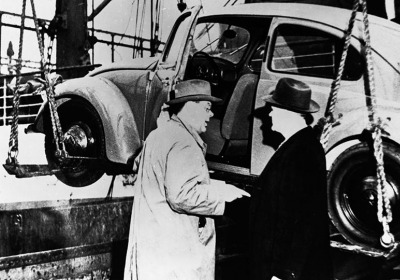The first Volkswagen Beetle in America looked like this
Thu, 30 Jan 2014
On Jan. 17, 1949, the Holland America Line Westerdam pulled into New York Harbor from Rotterdam carrying the seed of an automotive empire. It had been only four years since Volkswagen resurrected operations in Wolfsburg, the factory heavily ruined by Allied forces and now under the command of Major Ivan Hirst. The Wolfsburg plant itself was nearly dismantled under war reparations until Hirst persuaded the British Army to use its product as light transport. Successfully bowled over, the British placed an order for 20,000, the first of which went to occupying forces. 1,785 Type 1s were made that first year in 1945.
The Type 1 Beetle was a car that the British, in an official report, had deemed too ugly and noisy, "...quite unattractive to the average motorcar buyer." Hell, the Brits had tried to unload Volkswagen to Ford -- for free. The response from a Mr. Ernest Breech, chairman of the Ford board, was: "I don't think what we're being offered here is worth a damn!"
Oh, how they laugh now.
Max Hoffman, importer of all Europe's glamour, was the first official Volkswagen dealer in America. He, of course, is both famous and infamous in the automotive business, and his thriving showroom on Park Avenue would become legend. But there remains another figure much less known who was instrumental in bringing Volkswagen to America: Ben Pon, a former race-car driver from the Netherlands who was the first man to bring Volkswagens out of Germany.
On a wintry day in January 1949, Pon actually beat Hoffman to the chase. The entire operation was nearly derailed from the start. Pon held a press conference on the Westerdam to a small group of assembled journalists, who, in their trademark snark and smarm, derided the goofy Beetle as "Hitler's car." In a footnote all too familiar to us today, Pon called the VW the "Victory Wagon." We did win, after all! Pon peddled the car up and down the East Coast, hoping to strike a deal with any interested dealers. The Volkswagen was successful in his native Rotterdam; why wouldn't it be here? Three weeks later, he gave up. He hastily unloaded one Beetle, for exactly $800, just to settle his bill at the Roosevelt Hotel. 1949 ended with exactly two Beetles sold.
The next year, Hoffman showed up and became the official importer. He sold 157 Beetles.
Sixty-five years later, Volkswagen has announced plans to celebrate the car that, in essence, beat the odds. From 1949 to 1977, precisely 21,529,464 Beetles rolled out of dealer showrooms around the world. And so has the company expanded with it -- from the humble Beetle, Volkswagen has become the monolithic empire we know it to be today -- 11 models of Volkswagen and 10 brands within Volkswagen Group, the second largest automotive empire in the world.
"Since its arrival in the United States 65 years ago, the Volkswagen Beetle has preserved its reputation of being more than just a car but a symbol of uniqueness and freedom," said Michael Horn, the newly appointed president and CEO of Volkswagen in America (who has a big job ahead of him). "The Beetle has become part of the cultural fabric in America, and we are proud that its rich heritage continues to live with fans around the States."
Volkswagen
A 1949 Volkswagen Beetle, looking forlorn in the corner.
Rare photos of that first Beetle are shown above -- similar to this dark blue split-window, whose sales on both continents boomed under the efforts of former Opel manager Heinz Nordhoff. By 1955, the same year Volkswagen established a base of operations in Englewood Cliffs, N.J., the Wolfsburg plant had already churned out one million cars. ("If Beetles drove in three rows," proclaimed a German commercial in 1955, "They would form an uninterrupted row from Prince Edward Island to Gibraltar.") Like the Citro
By Blake Z. Rong



